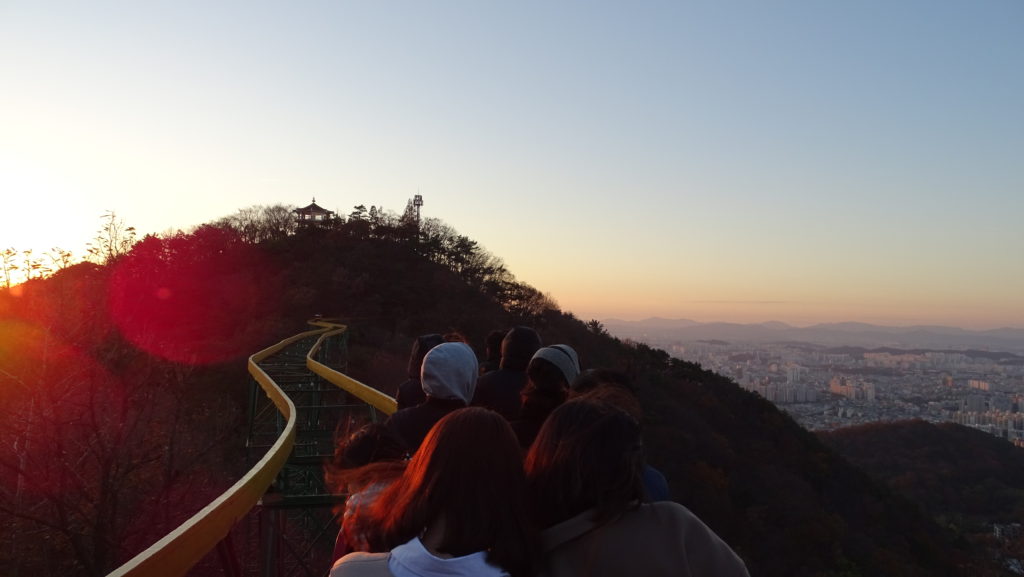Rooftopping in the City of Heights
Written and photographed by Isaiah Winters.
“Rooftopping” is a pretty self-explanatory neologism that refers to accessing rooftops, often high ones, within the context of urban exploring. Like hikers scaling a mountain, many do it for the simple thrill of ascending urban peaks; however, to an unfortunate few, rooftopping is a way to leverage most people’s healthy fear of heights for mindless online attention, often by doing stupidly risky stunts. As I want to live a long life, I prefer to have my cake and eat it too by simply enjoying the ascent and beautiful views without risking my life over vacuous antics.

In this month’s edition of Lost in Gwangju, I’ll share some of my more memorable photos and experiences related to extreme heights in the City of Light, starting with what was until last year the tallest building in Gwangju: Yang-dong’s KDB building. At 30 stories high, the KDB building is easily the tallest building for miles around, and this affords visitors an unobstructed 360-degree view of Gwangju’s bustling cityscape. The only problem is that your chances of accessing the rooftop are next to nil. It’s regularly on lockdown and the security guards are extra keen to pursue people – especially foreigners – who suspiciously take the elevator straight to the top, doubly so since the top floor isn’t in regular use these days.
Fortunately for my readers, yours truly is a different breed of persistent. After years of hit-and-miss ascents, I finally got lucky last fall when a construction crew working on the top floor let me slide past with little more than a shrug of their shoulders. As far as inner-city views of Gwangju go, this one is absolutely unparalleled. Blessed with clear weather and unusually good air quality that day, the amount of detail captured in a single frame – no matter the direction – was inspiration enough for an entire article. As for photos included in this article, one is looking broadly southeast towards Mudeung Mountain, while the other is a close-up of many of Gwangju’s taller buildings lining Geumnam-ro. Sadly, I doubt I’ll ever get to take photos again from this vantage point on a similarly photogenic day.

As proof of how closely guarded this rooftop is, just a few weeks later, my friend Ryan and I pressed our luck and tried to make the same ascent, only to get hounded down by security in mere minutes. Confronting us on the top floor, the guard was more startled than upset by our presence. But even if you get past the guards, locked doors are typically all that greet you, unless you’re my unlucky friend Lex. On our first visit to the top floor back in 2013 – back when it used to be an abandoned wedding hall – she came nose to nose with a terrified squatter who hid behind a dressing room door after he’d heard us snickering at all the bizarre costumes in the room. After seeing him, she power-walked up to me, eyes bulging, and shout-whispered, “There’s a man!” It wasn’t until we reached the ground floor that she, hyperventilating, finally explained what’d happened. These days, the squatter and wedding hall are long gone, though the glittering bridal photo room inexplicably remains.

While the KDB rooftop may be off limits, there are quite a few other rooftops around the city that are, at least ostensibly, freely accessible to the public. Among these, some are completely unguarded and easy to get to, while others are so convoluted to reach that many will likely give up or lose their nerve in the process. Some have security guards that are surprisingly reasonable, provided you can explain yourself in Korean; however, more often than not, they’ll deny you access no matter what your justification is. Understandably, they simply don’t want to be held responsible for anything that might go wrong.

If rooftop run-ins with security aren’t your thing, but you still want to enjoy exceptional views of Gwangju from high up, the Sajik Observation Tower in Yangrim-dong is a safe and family-friendly vantage point that’s open to the public. Another alternative is Cloud Bridge, which spans a high, narrow valley in Nam-gu between Jinwol-dong and Bongseon-dong and is freely accessible 365 days a year. Best of all is probably the ski lift in Jisan-dong, with the additional option to take the vertigo-inspiring monorail to the octagonal pavilion overlooking Chosun University, as well as the rest of the city. In other words, for most people, there’s no reason to take risks with rooftopping when so many other good alternatives exist.

Speaking of risks, another acrophobic exercise worth mentioning is crane climbing, which is kind of like rooftopping’s drunk, gambling-addicted uncle. Obviously, this comes with a serious risk-reward tradeoff favoring the former, and should be avoided by just about everyone. I definitely had a crane-climbing phase back when I was a testosterone-addled 20-something, but these days I’m finding better and better excuses for why not to climb cranes, which assuages my aging ego. As a recovering acro-holic, I hope you’ll take my advice and play it safe.
THE AUTHOR
Originally from Southern California, Isaiah Winters is a Gwangju-based urban explorer who enjoys writing about the City of Light’s lesser-known quarters. When he’s not roaming the streets and writing about his experiences, he’s usually working or fulfilling his duties as the Gwangju News’ heavily caffeinated chief proofreader.







